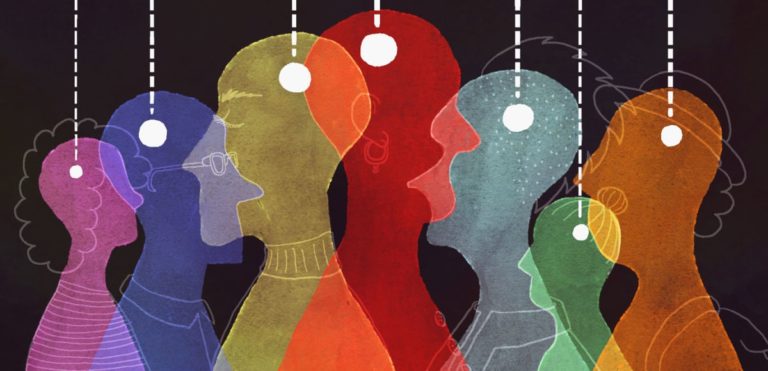Back when I lived in Japan, a Tokyo department store set up an Easter presentation one year that raised a few eyebrows: the store window displayed a cross with a bunny in place of Christ.
I had lived in Japan long enough to know that far from being intentionally offensive, whoever created the mash-up was probably just being clueless about Easter’s Christian origins as well as the pagan inspiration for the now ubiquitous, tacked-on secular bunny rabbits.
This was in the mid-1990s and thus before the Internet might have provided a corrective, or a quick backlash. Today the Easter bunny crucifix is a good example of what some might call “cultural appropriation”. In a less sensitive age, we’d have called it a clumsy, misguided attempt to borrow iconography from outside one’s own experience and culture.
Now, with the recent return to identity politics, i.e., the defining of identities with reference to ethnicity, skin color or gender, such cultural borrowing – “appropriation” is routinely, roundly condemned.
The prom dress that launched a thousand tweets
A few weeks back an online scold tried to shame Keziah Daum, a Salt Lake City teenager, for daring to wear a qipao as a prom dress. The qipao is a dress now generally associated with China although it originated with the minority Manchu and was “appropriated” by the majority Han Chinese, who in the 1920s slimmed down the gown from its original, more baggy appearance. But I digress: “My culture is NOT your god**** prom dress,” barked Jeremy Lam in a tweet aimed at Daum, which set off yet another tweeting firestorm.
Some joined the attack on the 18-year-old Daum for her prom-dress choice. Others defended her. Still others did what sensible people should do: mock the attackers with lighthearted examples of other “dresses” made from imagery from others’ cultures, involving everything from Bud Light beer labels to Swedish IKEA recycle bags. The absurd controversy made news in mainland China, Hong Kong and Taiwan. In such locales the apparently mainstream response was: we’re flattered, borrow away.

This kind of thing may seem silly and inconsequential but it’s actually a manifestation of a dark and dangerous cultural puritanism that poses a genuine threat to social cohesion. The cultural purists should think harder about the implications of their attempts to enforce rigid cultural boundaries and purist notions of cultural ownership. Such attempts to be uber-authentic have often been reflective of rabid local intolerance and are at their core, illiberal.
The long, illiberal history of cultural puritanism
For example, consider a few comments from late eighteenth and early nineteenth-century thinkers in one country that, after repelling foreign colonialists, thought it would be a good idea to resurrect a more “authentic” culture and thus a “purer” nation.
In this nation, one influential philosopher argued that authentic culture was rooted in an assumed organic unity of his people based on soil, “blood”, ethnicity and religion. Later, a prominent nationalist, poet and educator argued that the people of this nation had, unlike their neighbours, “not been bastardized”. He preferred “his” people stay that way.
The first thinker was the German poet Johann Gottfried Herder, writing while German lands were still occupied by the French; the second was Ernest Moritz Arndt, a post-French occupation evangelist for revived German nationalism. Arndt was a hero for opposing serfdom and the French presence but he defined his nationalism in “earthy” categories which excluded foreigners from the possibility of ever becoming truly German. “Foreigners” included even German-born non-Protestants; and of course, it included Jews.
German philosophers didn’t always think this way. For most of the eighteenth century, most German intellectuals and much of Europe believed in Enlightenment ideals including the inherent worth of the individual and the right to be defined as such and not as an assumed part of a collective. But later German academics, philosophers and their students became enamoured with purifying German culture of all so-called foreign contaminants, all cultural borrowing. That included opposition to specifically British ideals about liberalism and individualism, and an open, free trading economy. Many nineteenth century Germans saw all such notions as polluting their “pure” culture.
Sound familiar?
Young, impressionable, and dangerous
The young are often early adopters of extreme ideas, and in early nineteenth century Germany, students lapped this stuff up. One example: The first major gathering of nationalist student clubs took place at the Wartburg Castle, near Eisenach, on 18 October 1817. It was there, at a Woodstockian festival for young nationalists, that 450 students gathered to celebrate the four-year anniversary of Napoleon’s defeat by German forces. For some students, it was also a chance to dispose of “reactionary” literature and books blamed for “poisoning the Volk culture”. All such works and others were heaped onto bonfire stacks and burned. The philosopher Friedrich Ludwig Jahn, a renowned German “father of gymnastics” who was popular with students and a nationalist pied piper, was later found to have instigated the fires.

Arabic numbers, civil rights and American jeans: All appropriated
In contrast to such narrowly focused tribalism, cultural borrowing is often positive and can lead to societal progress. When Europeans appropriated Arabic numbering circa the twelfth century and dropped their own more “authentic” system of Roman numerals, that allowed for multiple benefits, starting with easier mathematical calculations.
Imagine trying to multiply CXXXV by XXII and your answer is MDCXX (135 x 22 = 1,620), or any such complicated formula. Fact is, actuarial tables, modern science and economics among many fields would not have developed absent the adoption – appropriation – of a superior numbering system. Also, of relevance: Arabic numbers were borrowed from India half a millennium before
Cultural borrowing and benefits can also travel in the opposite direction: should non-European cultures and nations have been discouraged from abolishing slavery because the original abolitionists were British, Canadian and American? Or because they were largely inspired by the evangelical Christian notion that men and women are made in the image of God and thus have a right to freedom on that basis? Likewise, should gender equality be dismissed because Western suffragettes were mainly white women?
Not to give the identity police ideas, but if a prom dress and much else should be restricted only to their original cultural inventors, why stop there? The don’t-appropriate-my-culture crowd, to be consistent, should demand that only Tokyo chefs prepare sushi, that only Ethiopians drink coffee, that only British men wear suits, and that no one except Americans and preferably those from the Western part of the United States wear jeans. After all, all of those are examples of original cuisine, drink and clothing inventions that later went “viral” and were adopted by others.
Alternatively, perhaps a great numbering system and terrific ideas about men and women and their intrinsic worth – and even beautiful clothes and cuisine – should be appropriated by anyone, anywhere, at any time. Forget the sensitive not-my-culture/not-your-culture touchiness.
Give up the notion of cultural purity
Which is to say: Cultural purists, especially in the mass travel and internet age, are in denial about the reality that no society is culturally “pure” and that is most often a good thing.
While culture exists and matters for a whole host of reasons, not least for understanding why a person might think the way they do, or why certain institutions developed, culture itself is porous and constantly changing. Any attempt to subvert that natural exchange and instead ground culture in unchangeable characteristics such as ethnicity or skin colour – instead of laudable ideas which can be shared by all – is pernicious. A tack to cultural purity is usually a sign that minds and hearts have begun to close, the potential for learning from others is at an end, and the risk of inter-cultural conflict is on the rise.
We need more cultural sharing and so-called appropriation, not less. And when someone gets it wrong – like the Tokyo department store – we should cut them some slack. Life is too short, and social harmony is too fragile, to build walls and grudges between people and cultures. We need not return to the world of cultural ghettoes.






